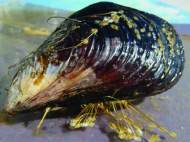Self-healing sticky substance inspired by mussels
 Inspired by the hair-thin holdfast fibers that mussels secrete to stick against rocks, researchers from the University of Chicago managed to manufacture a synthetic version of the self-healing sticky substance used by mussels. The substance could be used as an adhesive or coating for underwater machinery or in biomedical settings as a surgical adhesive or bonding agent for implants.
Inspired by the hair-thin holdfast fibers that mussels secrete to stick against rocks, researchers from the University of Chicago managed to manufacture a synthetic version of the self-healing sticky substance used by mussels. The substance could be used as an adhesive or coating for underwater machinery or in biomedical settings as a surgical adhesive or bonding agent for implants.
“Everything amazingly just self-assembles underwater in a matter of minutes, which is a process that’s still not understood that well”, said Niels Holten-Andersen, a postdoctoral scholar with chemistry professor Ka Yee Lee at the University of Chicago. “The mussels that live right on the coast where the waves really come crashing in have had to adapt to that environment and build their materials accordingly.”
Previous research regarding mussels adherence dates several years back, and various groups of researchers tried to establish that an unusual amino acid called “dopa” was the key ingredient responsible for mussel’s ability. Last year, researchers from the Germany’s Max Planck Institute discovered more details about mussel-fiber chemical bonds. The Max Planck collaboration included Holten-Andersen and Herbert Waite of the University of California, Santa Barbara. Holten-Andersen began researching the hardness and composition of mussel coatings as a graduate student in Waite’s laboratory.
Many existing synthetic coatings involve a compromise between strength and brittleness. Those coatings rely on permanent covalent bonds, a common type of chemical bond that occurs between two atoms which share electrons. Contrary, the bonds of the mussel-inspired material are linked via metals and exhibit both strength and reversibility.
“These metal bonds are stable, yet if they break, they automatically self-heal without adding any extra energy to the system”, said Holten-Andersen.
A key ingredient of the material is a polymer, which consists of long chains of molecules, synthesized by Phillip Messersmith from the Northwestern University. When mixed with metal salts at low pH, the polymer appears as a green solution. But the solution immediately transforms into a gel when mixed with sodium hydroxide to change the pH from high acidity to high alkalinity. Holten-Andersen and his colleagues found that the gel could repair tears within minutes.
“You can change the property of the system by dialing in a pH”, said Ka Yee Lee. The type of metal ion added to the mix provides yet another method to tune the material’s properties, even at the same pH. A patent is pending on how to make the substance. Being able to manufacture green materials is another advantage of biomimicry.
For more information, read the paper published in PNAS named: “pH-induced metal-ligand cross-links inspired by mussel yield self-healing polymer networks with near-covalent elastic moduli”.









Nice to see more people use biomimicry to make things more efficient and green.
That looks nasty EWWWWWWWWW!!!!!!!!!!!!!!